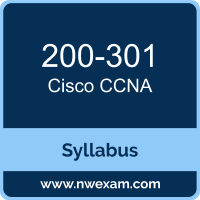 A great way to start the Cisco Certified Network Associate (CCNA) preparation is to begin by properly appreciating the role that syllabus and study guide play in the Cisco 200-301 certification exam. This study guide is an instrument to get you on the same page with Cisco and understand the nature of the Cisco CCNA exam.
A great way to start the Cisco Certified Network Associate (CCNA) preparation is to begin by properly appreciating the role that syllabus and study guide play in the Cisco 200-301 certification exam. This study guide is an instrument to get you on the same page with Cisco and understand the nature of the Cisco CCNA exam.
Our team of experts has composed this Cisco 200-301 exam preparation guide to provide the overview about Cisco Implementing and Administering Cisco Solutions exam, study material, sample questions, practice exam and ways to interpret the exam objectives to help you assess your readiness for the Cisco CCNA exam by identifying prerequisite areas of knowledge. We recommend you to refer the simulation questions and practice test listed in this guide to determine what type of questions will be asked and the level of difficulty that could be tested in the Cisco CCNA certification exam.
Cisco 200-301 Exam Overview:
|
Exam Name
|
Implementing and Administering Cisco Solutions |
| Exam Number | 200-301 CCNA |
| Exam Price | $300 USD |
| Duration | 120 minutes |
| Number of Questions | 90-110 |
| Passing Score | Variable (750-850 / 1000 Approx.) |
| Recommended Training | |
| Exam Registration | PEARSON VUE |
| Sample Questions | Cisco 200-301 Sample Questions |
| Practice Exam | Cisco Certified Network Associate Practice Test |
Cisco 200-301 Exam Topics:
| Section | Weight | Objectives |
|---|---|---|
| Network Fundamentals | 20% |
1. Explain the role and function of network components
2. Describe characteristics of network topology architectures
3. Compare physical interface and cabling types
4. Identify interface and cable issues (collisions, errors, mismatch duplex, and/or speed)
10. Verify IP parameters for Client OS (Windows, Mac OS, Linux)
12. Explain virtualization fundamentals (server virtualization, containers, and VRFs)
|
| Network Access | 20% |
1. Configure and verify VLANs (normal range) spanning multiple switches
2. Configure and verify interswitch connectivity
3. Configure and verify Layer 2 discovery protocols (Cisco Discovery Protocol and LLDP)
6. Describe Cisco Wireless Architectures and AP modes |
| IP Connectivity | 25% |
1. Interpret the components of routing table
2. Determine how a router makes a forwarding decision by default
3. Configure and verify IPv4 and IPv6 static routing
4. Configure and verify single area OSPFv2
5. Describe the purpose, functions, and concepts of first hop redundancy protocols |
| IP Services | 10% |
1. Configure and verify inside source NAT using static and pools 2. Configure and verify NTP operating in a client and server mode 3. Explain the role of DHCP and DNS within the network 4. Explain the function of SNMP in network operations 5. Describe the use of syslog features, including facilities and severity levels 6. Configure and verify DHCP client and relay 7. Explain the forwarding per-hop behavior (PHB) for QoS such as classification, marking, queuing, congestion, policing, and shaping 8. Configure network devices for remote access using SSH 9. Describe the capabilities and functions of TFTP/FTP in the network |
| Security Fundamentals | 15% |
1. Define key security concepts (threats, vulnerabilities, exploits, and mitigation techniques) 2. Describe security program elements (user awareness, training, and physical access control) 3. Configure and verify device access control using local passwords 4. Describe security password policy elements, such as management, complexity, and password alternatives (multifactor authentication, certificates, and biometrics) 5. Describe IPsec remote access and site-to-site VPNs 6. Configure and verify access control lists 7. Configure and verify Layer 2 security features (DHCP snooping, dynamic ARP inspection, and port security) 8. Compare authentication, authorization, and accounting concepts 9. Describe wireless security protocols (WPA, WPA2, and WPA3) 10. Configure and verify WLAN within the GUI using WPA2 PSK |
| Automation and Programmability | 10% |
1. Explain how automation impacts network management 2. Compare traditional networks with controller-based networking 3. Describe controller-based, software defined architecture (overlay, underlay, and fabric)
4. Explain AI (generative and predictive) and machine learning in network operations |
Cisco CCNA Exam Description:
CCNA Exam v1.1 (CCNA 200-301) is a 120-minute exam associated with the CCNA certification. This exam tests a candidate's knowledge and skills related to network fundamentals, network access, IP connectivity, IP services, security fundamentals, and automation and programmability. The course, Implementing and Administering Cisco Solutions (CCNA), helps candidates prepare for this exam.
